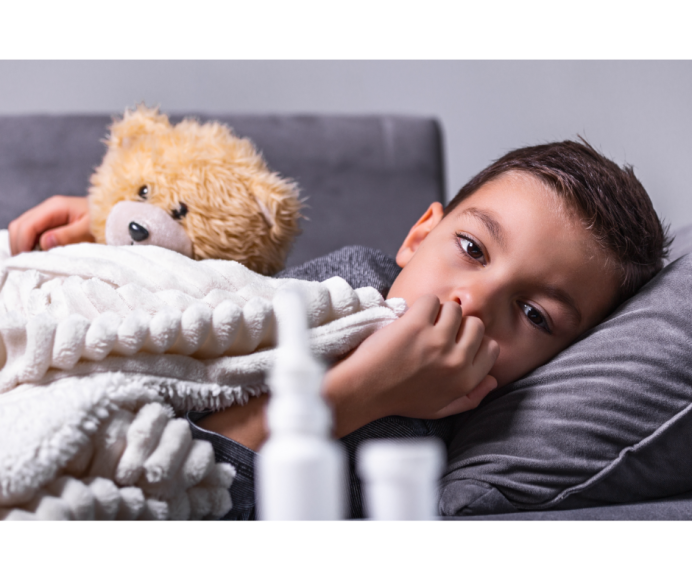Back to school signifies the end of relaxing summer days and the beginning of new things, such as: new clothes, new teachers, new friends, and, unfortunately, new and often multiple viral illnesses. Frequent viral illnesses are a normal part of childhood – I know, I know, insert eye-rolling emoji here! Another frustration is that many of them have few options for treatment, unlike bacterial infections.
While the back-to-back nature of these viruses can seem daunting, your child can expect to get six to eight viral illnesses a year. Last fall was a doozy for our pediatric patients, with multiple viruses hitting at the same time, and we are seeing a similar – though I pray milder – scenario this fall. Some viruses are more concerning than others. Let’s talk about the alphabet soup of some of the viruses I have been seeing and how you can manage them.
 RSV
RSV
RSV (respiratory syncytial virus) is a nasty little virus that infects the upper and lower respiratory tract. It can cause a range of cold symptoms from runny nose, fever, cough, etc., to bronchiolitis, which is a lower respiratory tract infection that can cause fast, hard breathing, grunting, flaring nostrils and wheezing. RSV is the most common cause of hospitalizations in children under age 1. Each year in the U.S., RSV causes the deaths of 400 to 800 children younger than 5. There are a few protective antibody treatments available to babies during RSV season to greatly lessen chances of hospitalization and death. Ask your doctor if Nirsevimab or Palivizumab is right for your child.
FLU A/B
Influenza, nicknamed the flu, and what I lovingly refer to as the “OG Pandemic Virus,” is another high-risk virus. This virus is a respiratory infection that causes symptoms such as high fevers, body aches, runny nose, and severe coughing that can last days. The illness can range from mild to severe and is often associated with some bacterial complications like pneumonia, ear and sinus infections, and sepsis. There is a flu vaccine formulated every season, and it has, year after year, demonstrated its efficacy in reducing hospitalizations and deaths in children. There are also some anti-viral treatments available to discuss with your doctor.
COVID-19
Yes, while no one is happy about it, COVID-19 is very active once again. Currently, it’s causing fever, runny nose, cough, body aches and other cold-like symptoms. While this strain seems a bit milder, in the sense that we are seeing less severity and less hospitalizations (thank God!), there are still some significant complications in high-risk pediatric patients (multifocal pneumonia, etc.). Concerns remain of children spreading to higher-risk adults. There is a safe and effective vaccine for children six months and older and some anti-viral treatments for certain risk groups.
Coxsackie Virus
While that name may be funny, it refers to the dreaded Hand Foot Mouth virus (HFM, as it’s lovingly known). This virus causes a fussy kid, a fever, and a blister-like rash located around the mouth, in the throat, on the palms and soles of the feet (though it really can be anywhere). This illness self-resolves.
Rhinovirus
There are about 200 viruses that can cause the common cold, but rhinovirus usually is the one we pick on when we say someone has a cold. These are typically very contagious infections of the respiratory tract that are medically mild but very annoying! These viruses cause fever, runny nose, sneezing, coughing, and headache. Here’s the worst part – SYMPTOMS CAN LAST 14-21 days! There is only symptomatic treatment like saline nasal irrigation, antihistamines, and fever reducers. Cough medicines and antibiotics DO NOT work! There is no vaccine because, while you may feel like you’re dying, death is not a complication.
Parainfluenza
This is another “cold” virus, but its “claim to fame” is that it causes croup (though all of the above-mentioned respiratory viruses can cause croup, too). Croup is the description of an inflammation of the voice box that causes a “barking seal” like cough and stridor. This funny-sounding cough is anxiety-provoking, but the illness is typically mild and self-limiting with a couple of home care tricks such as steamed air, cold air, etc. Some children may require a once-and-done steroid if the home care does not work. This is seen in kids 3 months to 5 years.
The GI Bug
There are a few seasonal GI bugs like norovirus and rotavirus. They cause fever, stomach discomfort, vomiting, diarrhea, and general malaise. This is a self-limited illness, in general, but we take care to watch for complications like dehydration. There really is no medicine for these viruses aside from waiting them out. The worst for moms is this common post-infectious diarrhea, a lingering soft stool for two to four weeks after the GI bug. There is a rotavirus vaccine for young babies because they are at risk for severe illness.
Roseola
Last but not least (well, not actually last, remember this is just a sampling of viruses) Roseola is a common childhood viral illness that was on a brief hiatus but is now making a comeback. Roseola is spread through droplets in children. It’s characterized by a high fever (103-104) that lasts 3-5 days with usually no other major signs of illness. The fever goes away suddenly, and an all-over body rash appears. This virus has been implicated in febrile seizures and the misdiagnosis of penicillin allergies as people get an antibiotic for a viral fever and the normal viral rash comes out (ask your doctor for details here).
 While I know these viruses and the illnesses they cause can seem overwhelming. There are a few tips to get through unscathed. Monitor your child’s symptoms, treat with some home care and TLC, and if symptoms last over 3 days or are ever worsening, call your pediatrician. From a prevention perspective, try to keep your child away from other children during the early and febrile portion of their illnesses as this is when they are the most contagious, get good sleep, a healthy balanced diet, hand wash and get VACCINATED! (Oh yeah, and masks do help stop the spread where appropriate.)
While I know these viruses and the illnesses they cause can seem overwhelming. There are a few tips to get through unscathed. Monitor your child’s symptoms, treat with some home care and TLC, and if symptoms last over 3 days or are ever worsening, call your pediatrician. From a prevention perspective, try to keep your child away from other children during the early and febrile portion of their illnesses as this is when they are the most contagious, get good sleep, a healthy balanced diet, hand wash and get VACCINATED! (Oh yeah, and masks do help stop the spread where appropriate.)

By: Diana Roukoz, DO FAAP, Mercy pediatrician. Dr. Diana Roukoz is a general pediatrician who has been with Mercy since 2014. She is married to her best friend and is a busy mom of three, loves to crochet, cook and craft.










